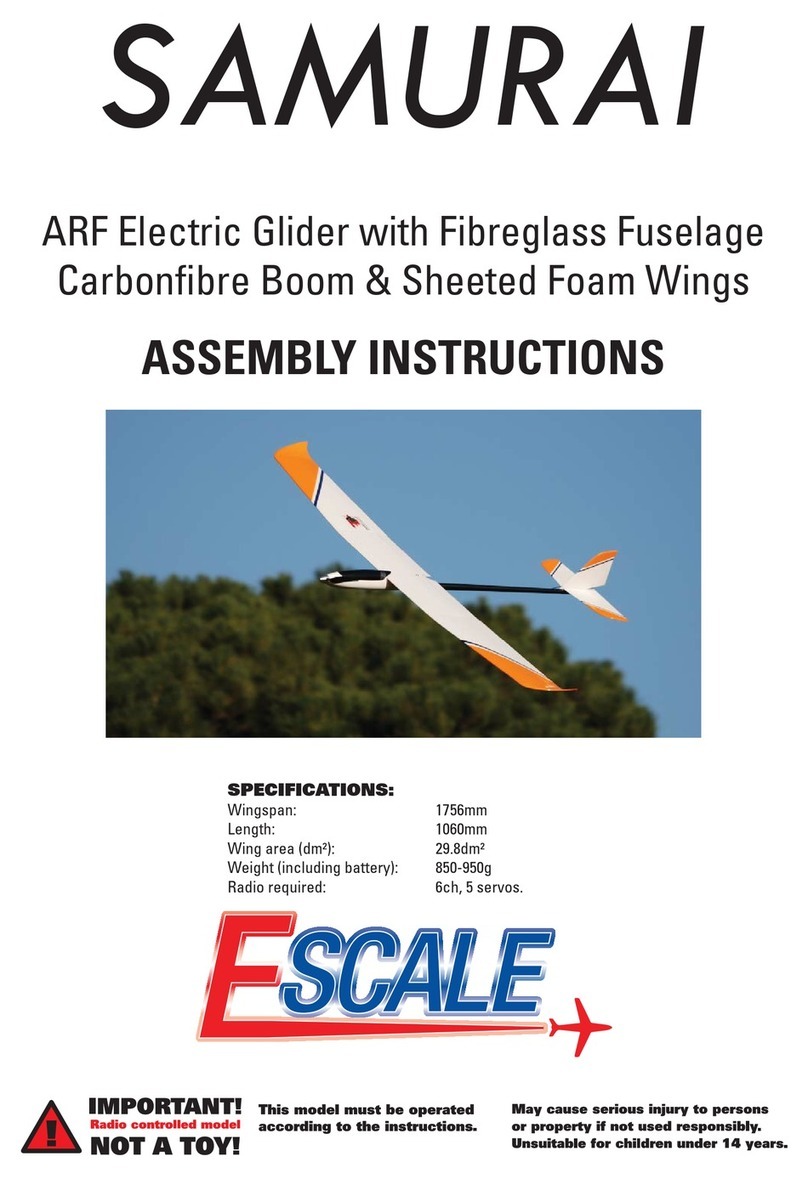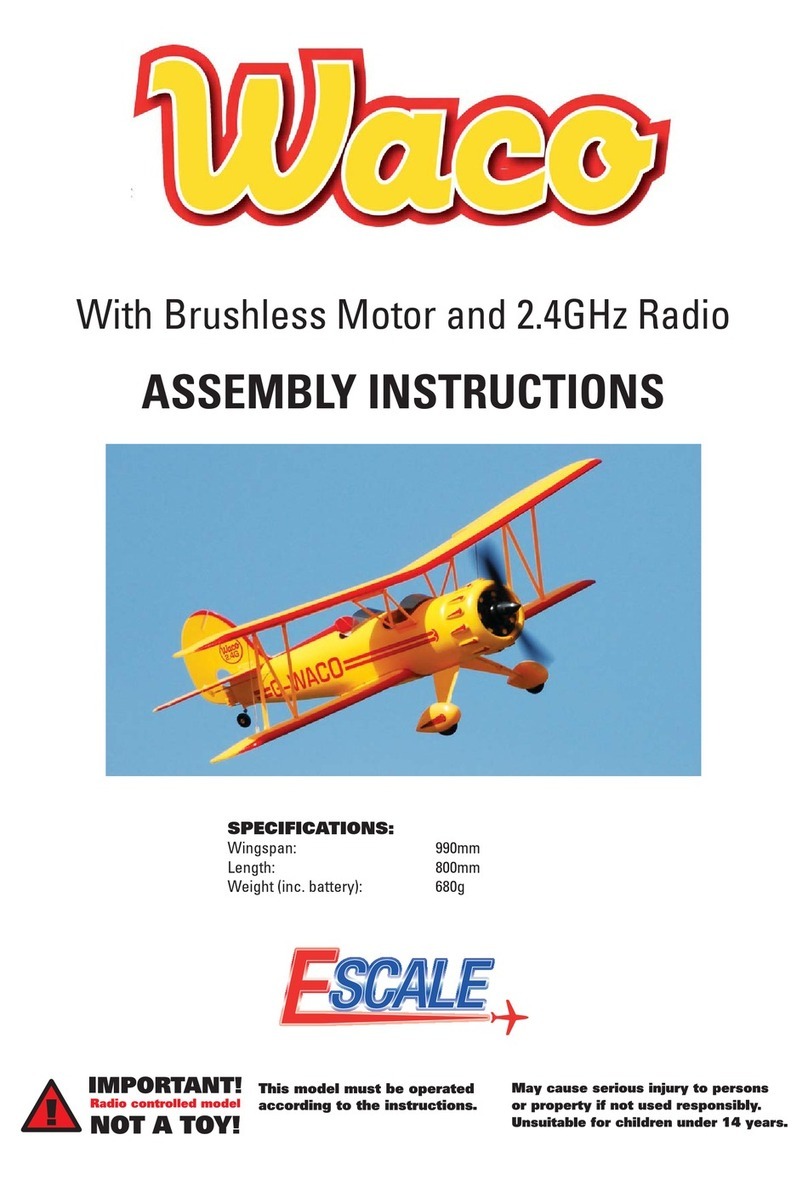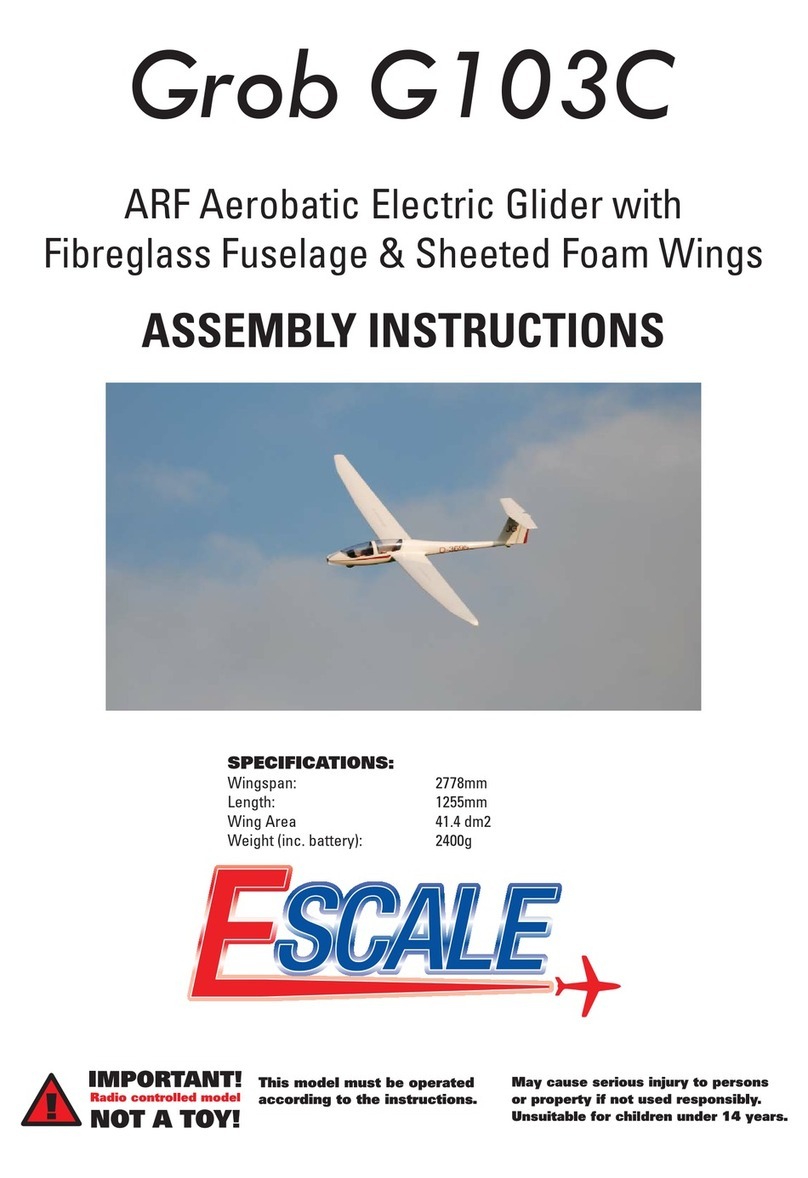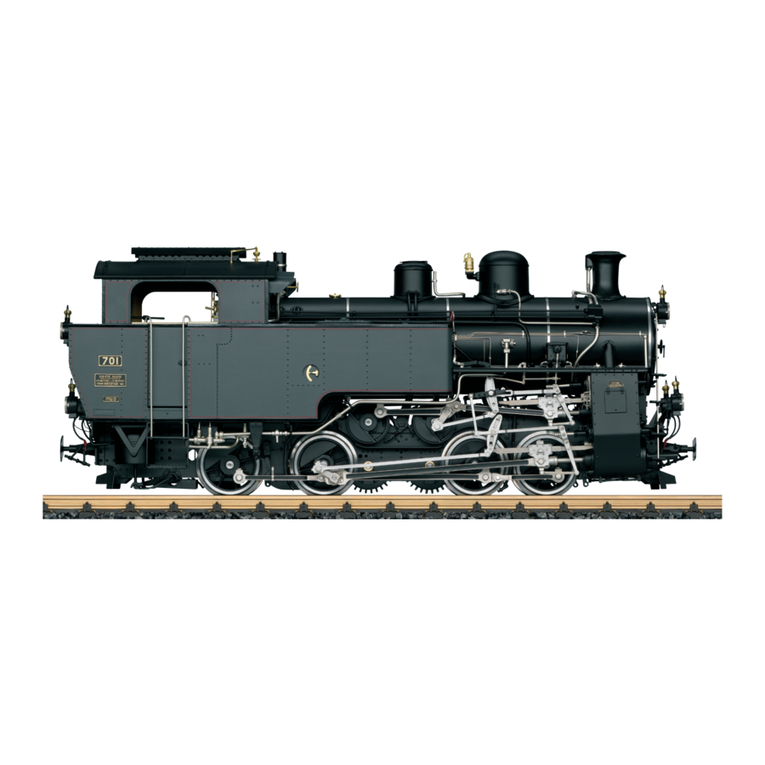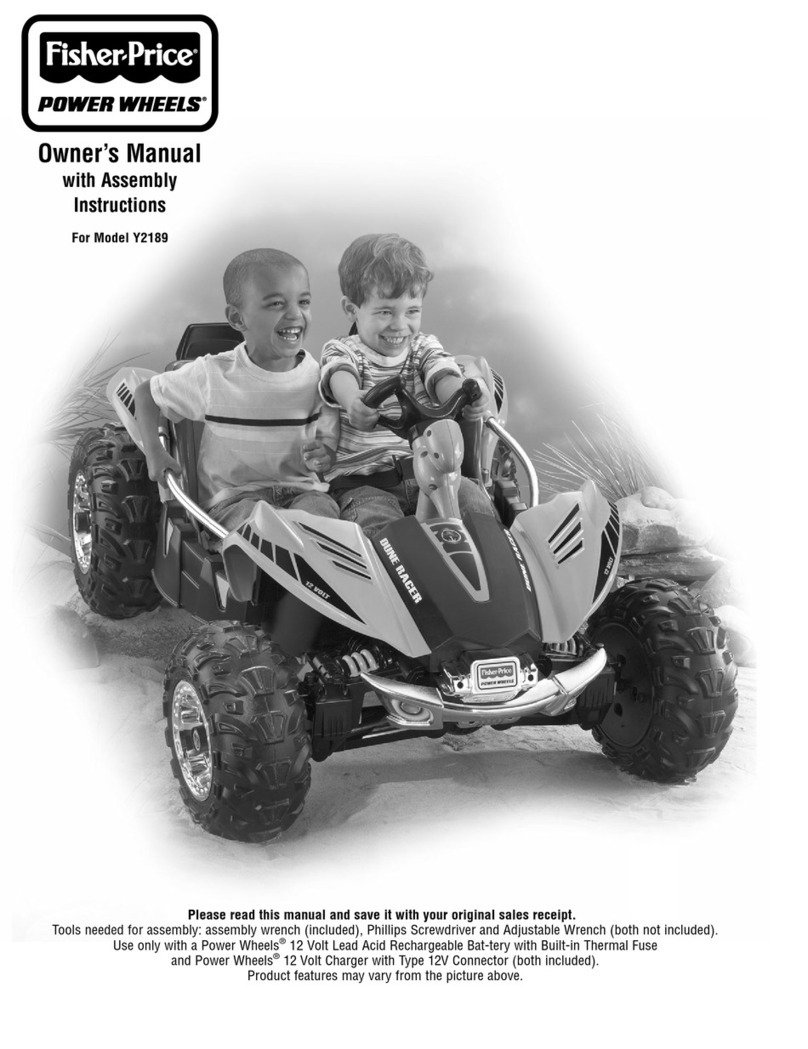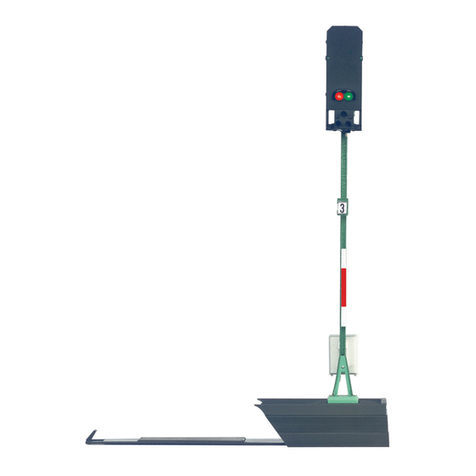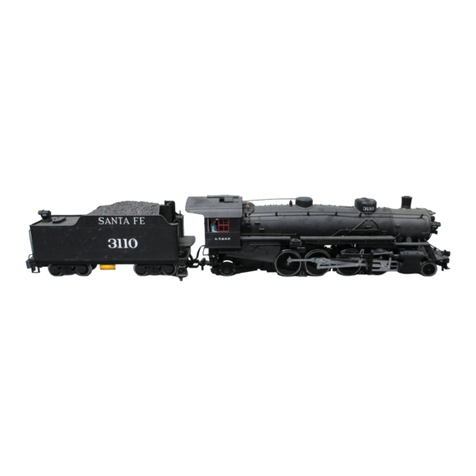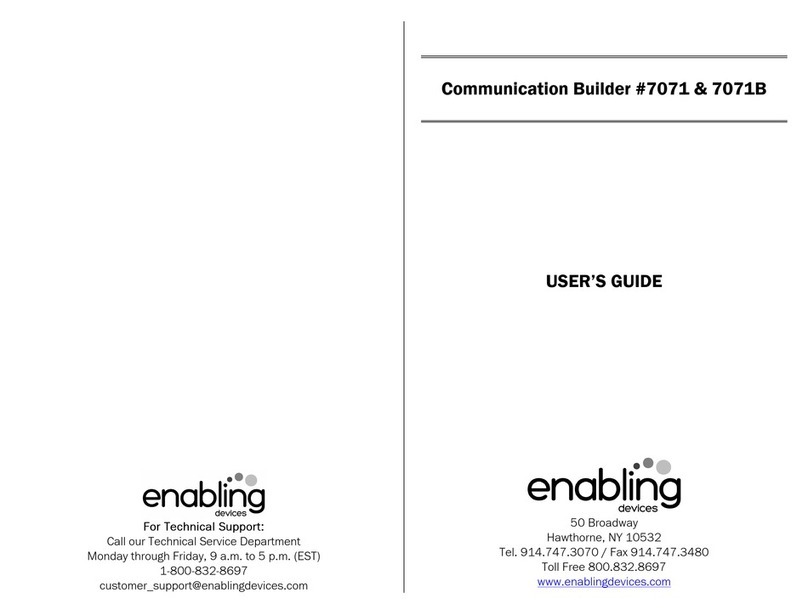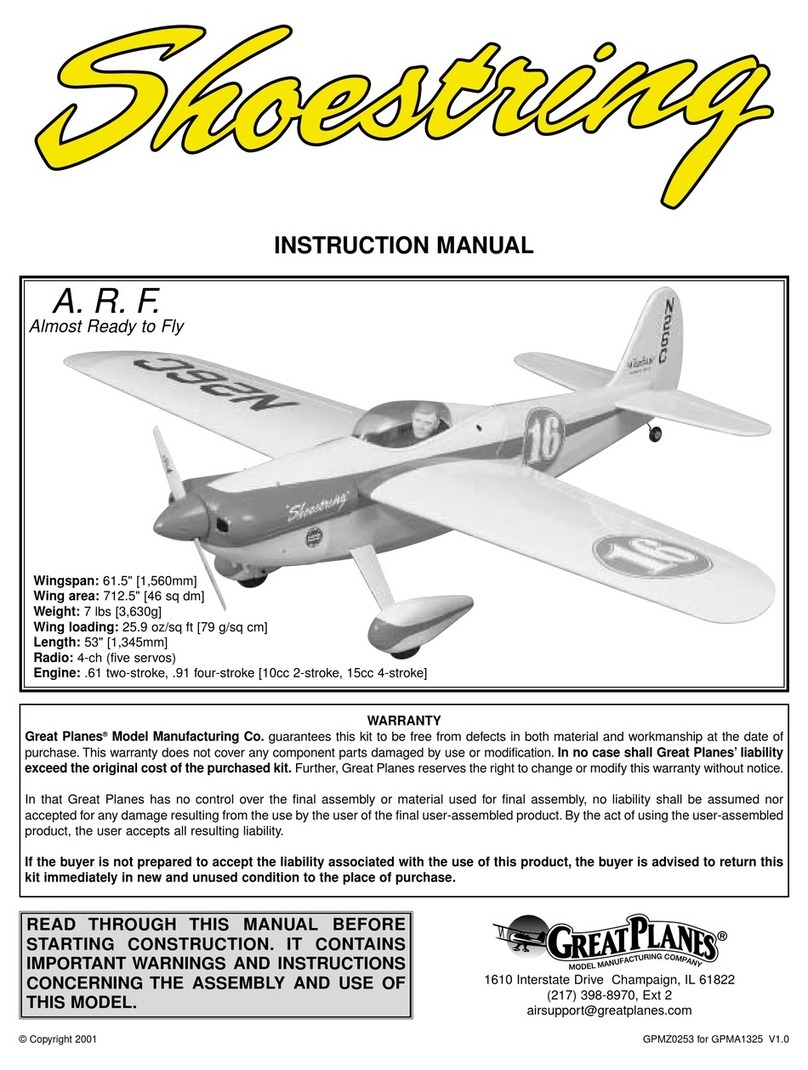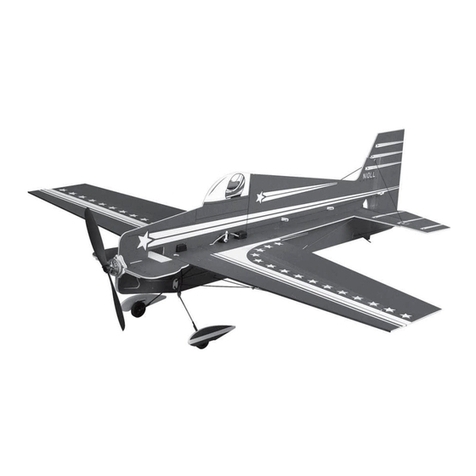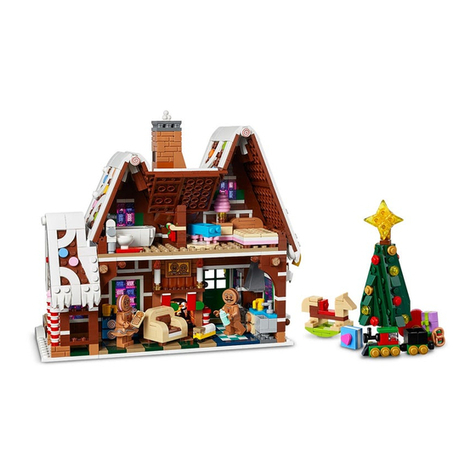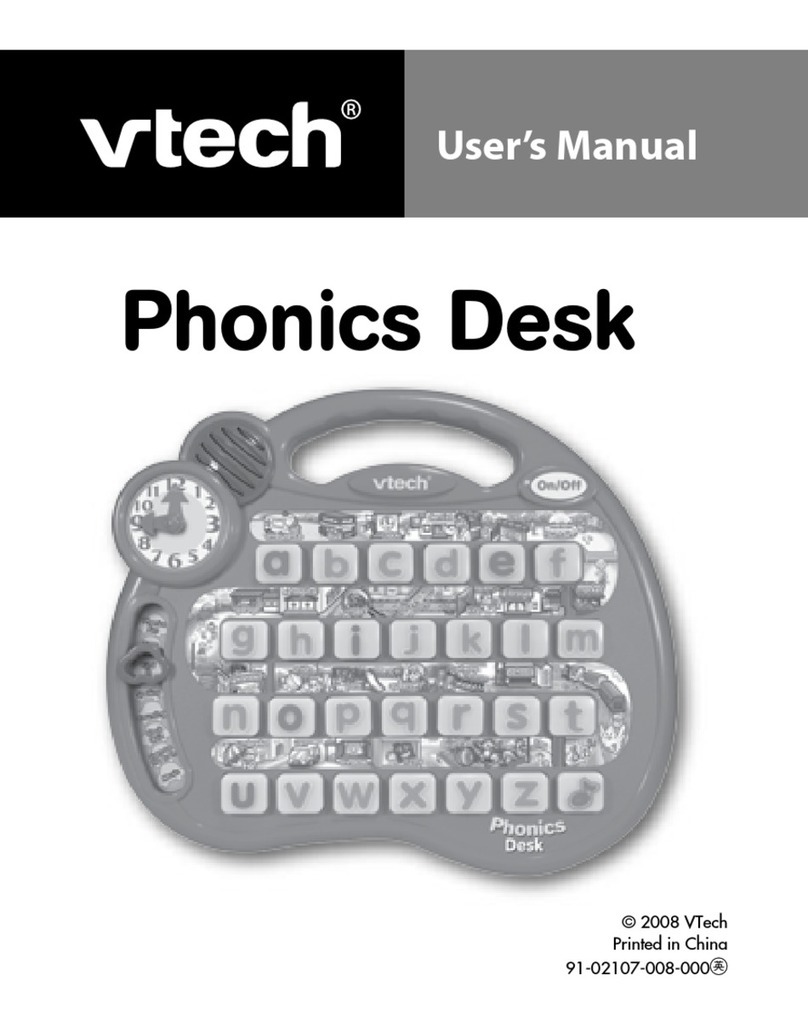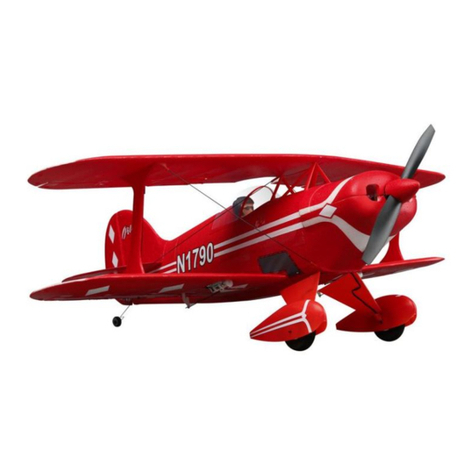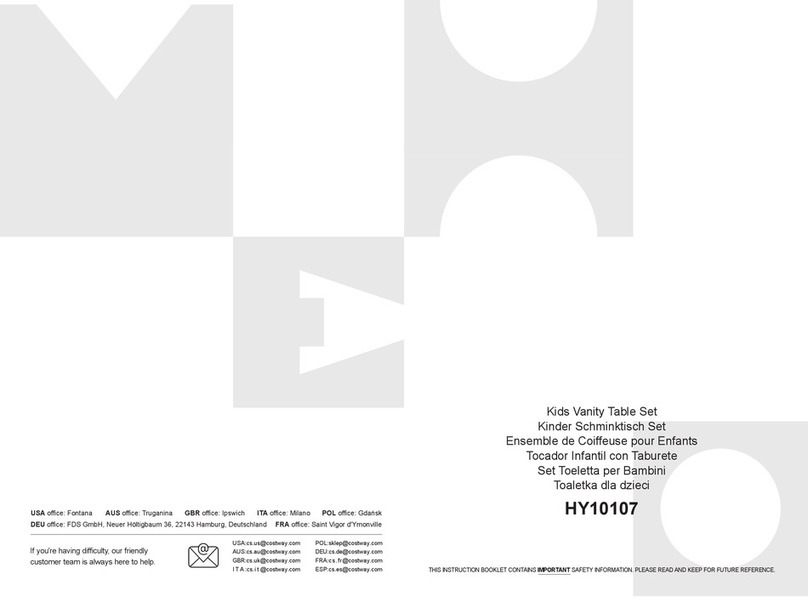EScale Seafire User manual

ASSEMBLY MANUAL
SpecificationS
Wing span ..............................64.6in (164cm)
Wing area ..................764.2sq.in (49.3sq dm)
Weight ......................................8.8lbs (4.0kg)
Length ....................................50.4in (128cm)
Engine .................... 0.75-0.91cu.in (2-stroke)
.................... 0.91-1.00cu.in (4-stroke)
Radio .................... 6 channels with 8 servos
Retracts landing gear (included)
Graphics and specifications may change without notice
Celebrating over 100 years of Naval Aviation!

Vital safety info
If you are a newcomer to R/C ight and have never
own a radio control model before; it is vital you
seek advice from an experienced model pilot on
where and how to y.
Only y in large open spaces that are approved for
R/C model ying and that are away from people,
animals, buildings, power lines, water or trees.
Only y in bright sunny conditions where wind speed
does not exceed 15mph.
Guarantee/warranty
J. Perkins Distribution Ltd. guarantee this product to be free of manufacturing and assembly defects for a period of one year from time of
purchase and Model Engines Pty Ltd. for 30 days. This does not affect your statutory rights. This warranty is not valid for any damage or
subsequent damage arising as a result of a crash, misuse, modification or for damage or consequential damage arising as a result of failure to
observe the procedures outlined in this manual. Operation of this model is carried out entirely at the risk of the operator. Please note that, whilst
every effort is made to ensure the accuracy of instructions and material included with this product, mistakes can occur and neither J. Perkins
Distribution Ltd/Model Engines (Aust.) Pty. Ltd. nor it’s distributors will be held liable for any loss or damage arising from the use of this model or
for any loss or damage arising from omissions or inaccuracies in the associated instructions or materials included with this product.
We reserve the right to modify the design of this product, contents and manuals without prior notification.
© 2011 J Perkins Distribution Ltd, Lenham, Kent, UK ME17 2DL. www.jperkinsdistribution.co.uk
Model Engines (Aust.) Pty. Ltd., Noble Park, Victoria 3174, Australia. www.modelengines.com.au.
All rights reserved. E&OE.

3Seare Instruction Manual
Thank you for choosing the EScale Seare ARTF. The EScale Seare was designed with the intermediate/advanced
sport yer in mind. It is a semi scale airplane which is easy to y and quick to assemble. The airframe is conventionally
built using balsa plywood to make it stronger than the average ARTF, yet the design allows the aeroplane to be kept
light. You will nd that most of the work has been done for you already. The motor mount has been tted and the
hinges are pre-installed. Flying the EScale Seare is simply a joy.
This instruction manual is designed to help you build a great ying aeroplane. Please read this manual thoroughly
before starting assembly of your EScale Seare . Use the parts listing below to identify all parts.
1
2 3
4
4
5
6
7 8
9
99
9 9
1 Fuselage with canopy
2 Left wing panel
3 Right wing panel
4 Tail set
5 Aluminium wing tube
6 Fiberglass cowl
7 Retracts landing gear
8 EP conversion pack
9 Hardware bag included
aDDitionaL iteMS reQuireD
■0.75-0.91 2-stroke. or 0.91-1.00 4-stroke
■Computer radio with 8 servos
■Glow plug to suit engine
■ Propeller to suit engine
■ Protective foam rubber for radio system
■Silicone fuel line
tooLS & SuppLieS neeDeD
■Thick cyanoacrylate glue
■ 30 minute epoxy
■ 5 minute epoxy
■ Hand or electric drill
■ Assorted drill bits
■ Modelling knife
■ Straight edge ruler
■ 2mm ball driver
■ Phillips head screwdriver
■ 220 grit sandpaper
■ 90° square or builder’s triangle
■ Wire cutters
■ Masking tape & T-pins
■ Thread-lock
■ Paper towels

4Seare Instruction Manual
3
ADDITIONAL ITEMS REQUIRED.
0.75-0.91 2-stroke.
0.91-1.00 4-stroke.
Computer radio with 8 servos.
Glow plug to suit engine.
Propeller to suit engine.
Protective foam rubber for radio
system.
Silicone fuel line.
TOOLS & SUPPLIES NEEDED.
Thick cyanoacrylate glue.
30 minute epoxy.
5 minute epoxy.
Hand or electric drill.
Assorted drill bits.
Modelling knife.
Straight edge ruler.
2mm ball driver.
Phillips head screwdriver.
220 grit sandpaper.
90° square or builder’s triangle.
Wire cutters.
Masking tape & T-pins.
Thread-lock.
Paper towels.
The control surfaces, including the
ailerons, elevators, and rudder , are
prehinged with hinges installed, but
the hinges are not glued in place. It
is imperative that you properly
adhere the hinges in place per the
steps that follow using a high-quality
thin C/A glue.
2) Remove each hinge from the wing panel
and aileron and place a T-pin in the center of
each hinge. Slide each hinge into the aileron
until the T-pin is snug against the aileron. This
will help ensure an equal amount of hinge is
on either side of the hinge line when the aileron
is mounted to the wing panel.
HINGING THE AILERONS
Note:
1) Carefully remove the aileron from one
of the wing panels. Note the position of the
hinges.
Hinge.
3) Slide the aileron on the wing panel until
there is only a slight gap. The hinge is now
centered on the wing panel and aileron.
Remove the T-pins and snug the aileron
against the wing panel. A gap of 1/64” or less
should be maintained between the wing panel
and aileron.
T-pin.
1 Fuselage with canopy
2 Left wing panel
3 Right wing panel
4 Tail set
5 Aluminium wing tube
6 Fiberglass cowl
7 Retracts landing gear
8 EP conversion pack
9 Hardware bag included
KIT CONTEN.TS

5Seare Instruction Manual
SEAFIRE.
4
8) After both ailerons are securely hinged,
firmly grasp the wing panel and aileron to
make sure the hinges are securely glued and
cannot be pulled out. Do this by carefully
applying medium pressure, trying to separate
the aileron from the wing panel. Use caution
not to crush the wing structure.
7) Repeat this process with the other wing
panel, securely hinging the aileron in place.
6) Using C/A remover/debonder and a
paper towel, remove any excess C/A glue that
may have accumulated on the wing or in the
aileron hinge area.
5) Turn the wing panel over and deflect the
aileron in the opposite direction from the
opposite side. Apply thin C/A glue to each
hinge, making sure that the C/A penetrates into
both the aileron and wing panel.
Work the aileron up and down several
times to “work in” the hinges and
check for proper movement.
Note:
HINGING THE ELEVATOR
Glue the elevator hinges in place using the
same techniques used to hinge the ailerons.
4) Deflect the aileron and completely
saturate each hinge with thin C/A glue. The
ailerons front surface should lightly contact the
wing during this procedure. Ideally, when the
hinges are glued in place, a 1/64” gap or less
will be maintained throughout the length of the
aileron to the wing panel hinge line.
The hinge is constructed of a special
material that allows the C/A to wick
or penetrate and distribute
throughout the hinge, securely
bonding it to the wood structure of
the wing panel and aileron.
Note:
Hinge.

6Seare Instruction Manual
5
HINGING THE RUDDER
Glue the rudder hinges in place using the
same techniques used to hinge the ailerons.
Hinge.
2 sets.
3x35mm.
ALUMINIUM WASHER.
ALUMINIUM WASHER.
CONTROL HORN
M3 SCREW.
18mm.
Epoxy.
Wing
Wing
Epoxy.
M3 LOCK NUT.
Aileron control horn.
INSTALL THE AILERONS CONTROL
HORN
1) Locate the hardware necessary to install
the control horns for the ailerons.
2) Position the control horn on the bottom of
the aileron. You will see pre-drill hole 3mm for
the horn mounting screw on the aileron.
3) Place epoxy into hole. This will harden the
threads and prevent the screws from pulling
loose.
4) Thread a control horn end with aluminium
washer, lock nut until the top edge of the end is
18mm from the base of the horn as shown.
3mm.
Install the flap control horn using the same
method as same as the aileron control horns.
INSTALL FLAP CONTROL HORN
2 sets.
3x30mm.

7Seare Instruction Manual
SEAFIRE.
6
3mm.
Flap control horn.
T-pin.
C/A glue.
C/A glue.
T-pin.
Install the elevator control horn using the
same method as the aileron control
horns.
INSTALL ELEVATOR CONTROL HORN
CONTROL HORN M3 SCREW.
M3 lock nut.
ALUMINIUM WASHER. 18mm.
ALUMINIUM WASHER.
Epoxy.
Epoxy.
Flap.
Aluminium Washer.
CONTROL HORN
M3 SCREW.
M3 LOCK NUT.
Epoxy.
Aluminium Washer.
Flap.
2 sets.
3x35mm.
3mm.

8Seare Instruction Manual
7
Rudder.
Aluminium Washer.
CONTROL HORN
M3 SCREW.
M3 LOCK NUT.
Epoxy.
Aluminium Washer.
Fuselage.
Fuselage.
18mm.
Epoxy.
Rudder.
INSTALL RUDDER CONTROL HORN
1 sets.
3x50mm.
Elevator control horn.
3mm.
Repeat steps to install the rudder control horn
as same as steps done for ailerons.
Aluminium Washer.
CONTROL HORN
M3 SCREW.
M3 LOCK NUT.
Epoxy.
Aluminium Washer.
Elevator.
Horizontal
Stabiliser.
18mm.
Epoxy.
Elevator.
Horizontal
Stabiliser.
Rudder control horn.

9Seare Instruction Manual
SEAFIRE.
8
ENGINE MOUNT INSTALLATION
1) Locate the items necessary to install the
engine mount included with your model.
2) Use four 4x30mm head bolts and four 4mm
washers to attach the engine mount rails to
the firewall. Tighten the screws. Make sure to
use threadlock on the screws to help prevent
them from vibrating loose.
4x30mm.
Thread locker glue.
1) Using a modelling knife, carefully cut
off the rear portion of one of the 3 nylon tubes
leaving 1/2” protruding from the rear of the
stopper. This will be the fuel pick up tube.
INSTALLING THE STOPPER ASSEMBLY
2) Using a modelling knife, cut one length
of silicon fuel line. Connect one end of the line
to the weighted fuel pick up and the other end
to the nylon pick up tube.
INSTALLING THE BATTERY
Battery.
Battery.
Tie wrap.

10 Seare Instruction Manual
9
You should mark which tube is the vent
and which is the fuel pickup when you attach
fuel tubing to the tubes in the stopper . Once
the tank is installed inside the fuselage, it may
be difficult to determine which is which
.
3) Carefully bend the second nylon tube
up at a 45º angle. This tube is the vent tube.
4) Test fit the stopper assembly into the
tank. It may be necessary to remove some of
the flashing around the tank opening using a
modelling knife. If flashing is present, make
sure none falls into the tank.
Vent tube. Fuel pick up tube.
Fuel fill tube.
5) With the stopper assembly in place,
the weighted pick-up should rest away from
the rear of the tank and move freely inside the
tank. The top of the vent tube should rest just
below the top of the tank. It should not touch
the top of the tank.
6) When satisfied with the alignment of
the stopper assembly tighten the 3 x 20mm
machine screw until the rubber stopper ex-
pands and seals the tank opening. Do not
overtighten the assembly as this could cause
the tank to split.
FUEL TANK INSTALLATION
7) Slide the fuel tank into the fuselage. Guide
the lines from the tank through the hole in the
firewall.
Plywood template.
Fuel tank.
8) Use plywood template to hold in place
the fuel tank with C/A glue to secure the fuel
tank inside the fuselage.
Plywood template.
C/A glue.
A.
C/A glue.
B.
B.
A.
C/A glue.

11Seare Instruction Manual
SEAFIRE.
10
Blow through one of the lines to en-
sure the fuel lines have not become kinked
inside the fuel tank compartment. Air
should flow through easily.
INSTALLING THE FUSELAGE SER VOS
Throttle servo.
Elevator servo.
Rudder servo.
THROTTLE SERVO ARM INSTALLATION
Install adjustable servo connector in the servo
arm as same as picture below:
Adjustable Servo
connector.
Servo arm.
Loctite secure.
1 PCS.
Throttle servo arm.
Elevator servo arm.
Rudder servo arm.
2) Install the rubber grommets and brass
collets onto the throttle servo. Test fit the servo
into the aileron servo mount.
3) Secure the servos with the screws pro-
vided with your radio system.
Because the size of servos differ , you
may need to adjust the size of the precut open-
ing in the mount. The notch in the sides of the
mount allow the servo lead to pass through.
3/ 32” Hole.
INSTALLING THE SWITCH
Install the switch into the precut hole in the
side, in the fuselage.
Vent tube.
Fuel pick up tube.
Fuel fill tube.
9) Connect the lines from the tank to the
engine and muf fler. The vent line will connect
to the muffler and the line from the clunk to the
carburettor.

12 Seare Instruction Manual
11
Switch.
Trim and cut.
145mm.
MOUNTING THE ENGINE
2) Use a pin drill and 2mm drill bit to drill a
small indentation in the mount for the engine
mounting screw.
3) Use a drill to drill the four holes in the engine
mount rails.
4) On the fire wall has the location for the
throttle pusshrod tube (pre-drill).
1) Position the engine with the drive washer
(145mm) forward of the firewall as shown.
4.5mm.
Pushrod tube hole.
4mm.
4.2mm.

13Seare Instruction Manual
SEAFIRE.
12
8) Reinstall the servo horn by sliding the
connector over the pushrod wire. Center the
throttle stick and trim and install the servo horn
perpendicular to the servo center line.
9) Move the throttle stick to the closed position
and move the carburetor to closed. Use a 2.5mm
hex wrench to tighten the screw that secures
the throttle pushrod wire. Make sure to use
threadlock on the screw so it does not vibrate
loose.
COWLING
Trim and cut.
1) Slide the fiberglass cowl over the engine
and line up the back edge of the cowl with the
marks you made on the fuselage then trim and
cut as shown.
Machine screw M4x30mm.
Pushrod wire.
Trim and cut.
7) Slide the throttle pushrod wire into the tube.
Position the engine between the mounts. Use
four M4x30mm machine screws to secure the
engine to the mount as shown.
5) Slide the pushrod tube in the firewall and
guide it through the fuel tank mount. Use
medium C/A to glue the tube to the firewall and
the fuel tank mount.
6) Connect the Z-bend in the 450mm throttle
pushrod to the outer hole of the carburetor arm.

14 Seare Instruction Manual
13
Because of the size of the cowl, it may be nec-
essary to use a needle valve extension for the
high speed needle valve. Make this out of suf-
ficient length 1.5mm wire and install it into the
end of the needle valve. Secure the wire in
place by tightening the set screw in the side of
the needle valve.
Machine screw M3x10mm.
Needle valve.
3) Install the muffler and muffler extension
onto the engine and make the cutout in the
cowl for muffler clearance. Connect the fuel
and pressure lines to the carburetor , muffler
and fuel filler valve. Secure the cowl to fuse-
lage using the M3x10mm screws.
2) While keeping the back edge of the
cowl flush with the marks, align the front of
the cowl with the crankshaft of the engine. The
front of the cowl should be positioned so the
crankshaft is in nearly the middle of the cowl
opening. Use the spinner backplate as a guide.
Hold the cowl firmly in place using pieces of
masking tape.
Trim and cut.
ELECTRIC POWER CONVERSION
1) Locate the items necessary to install the
electric power conversion included with your
model.
M3x15mm.
M4x20mm.
2) Attach the electric motor box to the firewall
suitable with the cross lines drawn on the electric
motor box and firewall. Using epoxy and balsa
stick to secure the motor box to the firewall.
Please see pictures below .
- Model size: .75-.90 size models
- Motor: 50mm 310 rev per volt
- Propeller: 14x10 ~ 15x10
- ESC: 60A
- Lipo Batteries: 8 cell 3200mA

15Seare Instruction Manual
SEAFIRE.
14
3) Attach the motor to the front of the electric
motor box using four 3mm blind nut, four
M3x15mm hex head bolt s to secure the motor .
Please see picture shown.
Epoxy.
110mm.
4mm.
4mm.
Balsa stick.
Epoxy.
M3x15mm.

16 Seare Instruction Manual
15
M3 x 15mm.
Electric motor.
Battery.
4) Locate the plywood battery tray to the
fuselage. Tighten the screws using machine
screws M3x15mm to secure the tray in position.
Blind nut.
M3 x 15mm.
Battery.
Speed control.
5) Attach the speed control to the side of the
motor box using two-sided tape and tie wraps.
Connect the appropriate leads from the speed
control to the motor . Make sure the leads will
not interfere with the operation of the motor .
INSTALLING THE SPINNER
Install the spinner backplate, propeller and
spinner cone.
The propeller should not touch any part
of the spinner cone. If it does, use a
sharp modelling knife and carefully trim away
the spinner cone where the propeller comes
in contact with it.

17Seare Instruction Manual
SEAFIRE.
16
3) Use drill bit in a pin vise to drill the mouting
holes in the blocks.
4) Apply 2-3 drops of thin C/A to each of the
mounting holes. Allow the C/A to cure without
using accelerator.
6) Secure the servo to the aileron hatch using
Phillips screwdriver and the screws provided
with the servo.
5) Use dental floss to secure the connection
so they cannot become unplugged.
7) Apply 1-2 drops of thin C/A to each of the
mounting tabs. Allow the C/A to cure without
using accelerator.
INSTALLING THE AILERON - FLAP SERVOS
Servos. Small weight.
Thread.
String.
Small weight.
1) Using a small weight (Weighted fuel pick-up
works well) and string, feed the string through
the wing as indicated.
2) Place the servo between the mounting
blocks and space it from the hatch. Use a pencil
to mark the mounting hole locations on the
blocks.
Because the size of servos differ , you
may need to adjust the size of the precut open-
ing in the mount. The notch in the sides of
the mount allow the servo lead to pass through.

18 Seare Instruction Manual
17
8) A string has been provided in the wing to
pull the aileron lead through to the wing root.
Remove the string from the wing at the servo
location and use the tape to attach it to the
servo extension lead. Pull the lead through the
wing and remove the string.
9) Set the aileron hatch in place and use a
Phillips screw driver to install it with four wood
screws.
AILERON PUSHROD HORN INSTALLATION
Mark.
Pen.

19Seare Instruction Manual
SEAFIRE.
18
Wing.
Aileron.
M2 lock nut.
Repeat the procedure for the other aileron servo.
Snap keeper.
Servo arm.
3) Connect the linkage as shown and secure
the control wire with a snap keeper.
8mm
Snap keeper.
M2 lock nut. Metal clevis.
1) Mark the control wire where it crosses the
servo arm hole.
Bend at the mark.
2) Make a 90-degree bend at the mark and cut
off the excess wire leaving 8mm past the bend.
Cut.
8mm.

20 Seare Instruction Manual
19
INSTALLING THE FLAP SERVO
M2 lock nut.
Wing.
Flap.
Repeat the procedure for the aileron servo.
WING ASSEMBLY
Masking tape.
Epoxy.
Masking tape.
Epoxy.
Epoxy.
1.
Epoxy.
1.
SERVO GEAR INSTALLATION
Servo for retractable only.
Metal connector.
Servo arm.
25mm.
Table of contents
Other EScale Toy manuals

